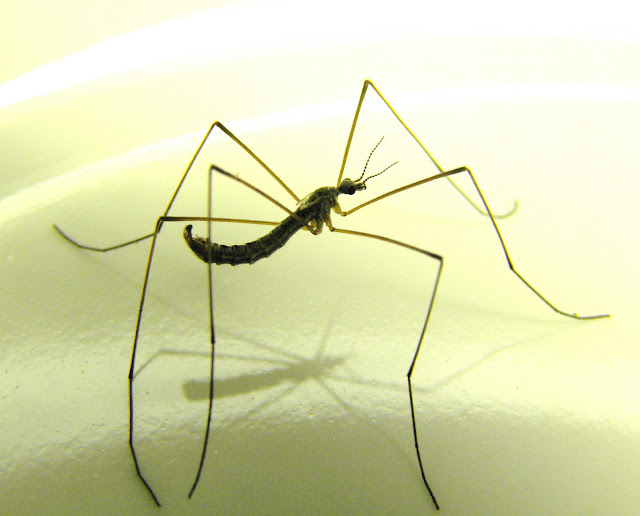Last night I found a few geometrid moths, some spiders, and a lonely click beetle. Two leggy insects looked like they might be a type of Thread-legged Bug. But the antennae seemed wrong and the abdomen too heavy. At closer investigation they clearly had the head of a crane fly, but no wings!
When I enlarged my photos I found that they did have tiny, obviously dysfunctional wings.
The other obvious difference to other crane flies was the body shape: The thorax was hardly wider than the elongate abdomen. 'Normal 'Crane Flies that have a pair of long narrow wings support those with a bulging, muscular thorax. No functional wings, no big flight muscles...
 |
| Dactylolabis (Eudactylolabis) vestigipennis |
The type specimen of D. vestigipennis, curated at the Smithonian was collected in the Tucson Mountains, and I found mine in the bajada of those mountains. Others were reported from the Mojave Desert further west and all around this time of the year.
This means that the temperatures that these nocturnal (?) crane flies are likely to experience during their adult lives are very low. In February the night temps in the Desert hover close to the freezing point. Yesterday I measured 36 F.
Flying is not only a high energy sport in itself, its apparatus also requires a certain minimum temperature to function. Many good fliers among insects, like bumblebees, sphingid moths and big beetles are able to generate the necessary heat metabolically. They shiver just like birds and mammals. So at times they are endotherm like those higher vertebrates. But while most birds and mammals maintain high body temperatures almost constantly, these insects turn on the heat production when needed, that is when they need to fly at low ambient temperatures.
The obvious reason is the cost of that heat production as the energy consumption of those shivering muscles is high. When bumblebees in cold climates live around flowers that provide only small amounts of nectar (asteraceae) they don't fly on cloudy days and remain cold-blooded, while those with access to high-yeald flowers (Fire Weed) will increase their body temperature and fly on rainy days. (Bumblebee Economics, B. Heinrich, 1979, Harvard University Press)
The small moths in the family Geometridae that are coming to the lights right now are unable to increase their metabolic rate for heat production. They don't have the energy to spare, because they don't feed as adults. Their mouth parts and digestive system are reduced and non-functional. Investment in these structures would be wasted because they fly mainly in winter when there are hardly any nectar-sources available, even here in Arizona. So they rely on the resources that they amassed during their larval state. Still, the light, slender males are able to fly in cold temperatures due to their large wing size and special adaptations in their enzymatic make-up. Interestingly, in many species the heavier females of these winter moths are wingless and earth-bound.
 |
| Dactylolabis (Eudactylolabis) vestigipennis |
Surprisingly little is known about crane flies, considering that some winged species are inch-long and in-your-face-obnoctious if you sit outdoors by candle light on warm summer evenings. The larvae usually feed on decaying plant tissue; some species are carnivorous, and others damage the roots of cereal and grass crops. Most are found in semi-aquatic or at least moist habitats. The feeding habits of the short lived adults are not well described. Some possess a long slender proboscis and feed on plant nectar. Not surprisingly, I couldn't find any info on the life cycle of this tiny (11mm) inconspicous species.
 |
| The tip of the abdomen |
 | |||
| the narrow thorax with reduced wings |
 |
| the head |
Winter and night activity opens an ecological niche to insects that have little other protection against predators. They live their adult lives in the cold, maybe without food, but also out of reach of day-active birds, summer-active bats, and most predatious insects so they can focus on their only purpose: finding a mate to propagate their genes.




Fascinating discovery. Nice detailed analysis of these creatures.
ReplyDeleteFascinating that those Crane Flies have evolved like that. I'm so glad I found you - I can send you all my pictures of crane flies that I can't identify now! Only joking. Fabulous photos.
ReplyDeleteWow, never heard of such a thing. Super photos. I also just started noticing some new moths at my porch light the past few days, but now I'm in Costa Rica where I might see a few more.
ReplyDeleteI had no idea there are flightless crane flies...... facinating.
ReplyDeleteHi, the specimens you photographed are definitely male. The pincer-like structures are male genitalia. I didn't know about this species, but the winter-active "snow" crane flies of the genus Chionea are also wingless. Cool stuff! Brian (flyobsession.net)
ReplyDelete